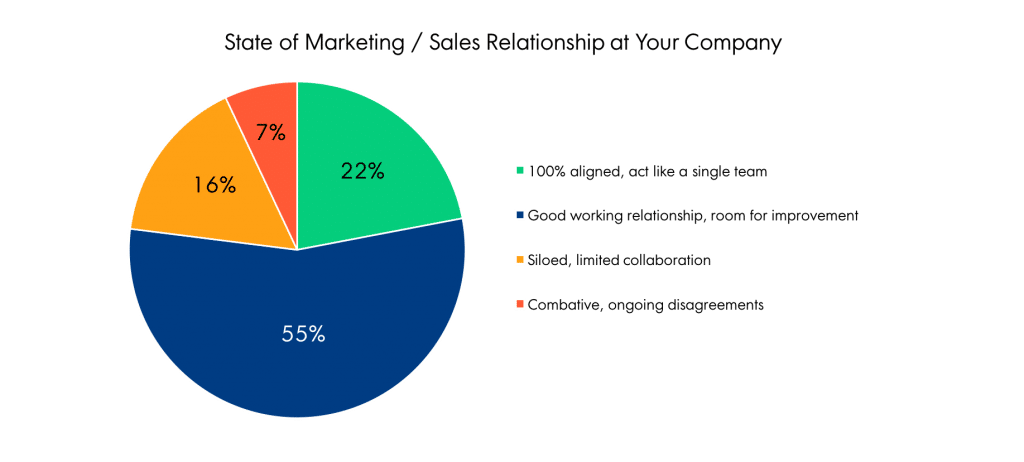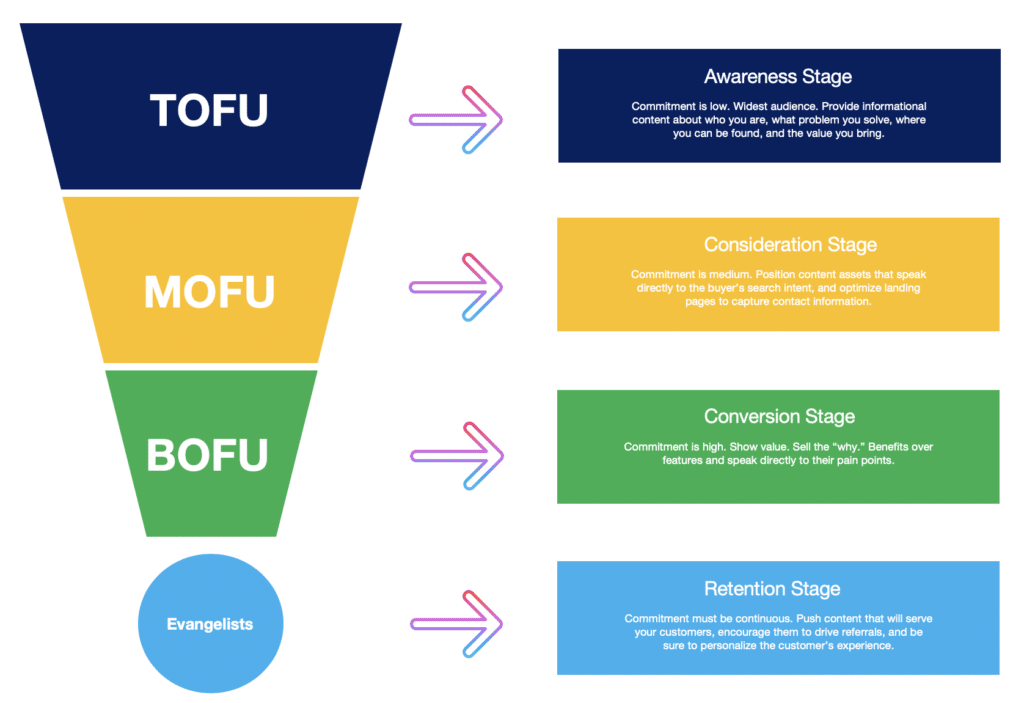An all-too-common scenario in many B2B companies is that sales are constantly complaining that they don’t have enough leads, while marketing feels that the leads they are sending over aren’t being followed up. There is validity to this last point because sales reps are known to ignore 50% of marketing leads. However, when both sales and marketing are in alignment, it can lead to 38% higher sales win rates.
Here are additional stats to know:
- Organizations with tightly aligned sales and marketing functions enjoy 36% higher customer retention rates.
- Sales and marketing alignment can help your company become 67% better at closing deals.
- Aligning both departments can help generate 209% more revenue from marketing.
- Companies with strong sales and marketing alignment achieve a 20% annual growth rate.
- Companies with poor sales and marketing alignment can cost 10% or more in revenue decline.
Keeping these stats in mind, here are some key points I’ll be discussing in today’s blog:
- How to develop a collaborative culture and process for sales and marketing
- Sales outreach ideas that still work
- Lead generation ideas that work well for marketing
- KPIs and metrics that will show whether or not sales and marketing are aligned
Sales and Marketing Collaboration FTW
The pressure for sales and marketing to perform well and to play an integral role in fostering growth initiatives is something that comes with the nature of being in business. That pressure can typically snowball into something negative, where each department starts blaming the other for not doing their part.

Rather than doing this, push forward with processes that work well for both. Working in silos is outdated for both departments and creates more friction than needed. I believe one of the key things to keep in mind is that no matter if you’re in sales or in marketing, you are both working for the same company and towards a collective goal.
Here are some key processes worth considering:
- Agree on what an MQL is and what an SQL is.
- Be accountable and humble.
- Have an open feedback loop on what’s working and what isn’t.
- Implement lead scoring and agree on where the SQL threshold is and what happens if leads reach that point but are still not ready to move forward.
- Over-communicate and be supportive (this means putting your ego aside).
The most important factor with successful collaboration is that everyone is accountable and that both parties do their part. The friction between sales and marketing arises and can continue when there isn’t accountability because then it’s all about finger-pointing. In turn, this causes teams to pull apart rather than working towards the same vision and goals.
I like to use Monday to organize projects for both departments and encourage accountability. Each department can have their own section, while color-coding can help us know what campaigns are aligned. It also helps to be able to see at a glance what everyone is doing so that you can see ways that you can better coordinate your efforts together.
Sales Should Hunt and Help
Let’s face it, no one really loves to hunt. This includes cold calling, cold emailing, and cold outreaches via social selling. You’ll hear and get a lot more “No, not interested” than you’ll ever hear “Yes!” This can feel discouraging and make it tough to stay motivated.
What if I told you that all of this still works? Yes, the cold calling, emailing, and outreach. It all still works. All that it truly takes is some grit and the willingness to be okay with hearing “no” while enjoying the process of climbing to the top. Here are some stats to prove this:
- 75% of prospects in some industries have attended an event or scheduled a meeting based on cold email or call.
- The ideal number of calls to win the sale is six.
- 50% of leads never get a second cold call from salespeople.
- 82% of buyers look up providers on LinkedIn before they respond to their outreach efforts.
- The best time to cold call is between 4:00 and 5:00 PM.
- Thursday is the best day to prospect. Wednesday is the second best day.
- 78% of salespeople using social media outsell their peers.

Grow Lead Gen Efforts and Get a 2x-4x ROI
In my personal experience, generating qualified leads for my clients with a typical ROI of 2x-4x is common. It’s certainly not a walk in the park as implementing the most effective and efficient lead generation campaigns need a solid strategy in place. More specifically, outsourcing lead generation creates 43% better results than in-house lead generation.
While 61% of marketers say that their top challenge is lead generation, take note of the following strategies to consider to help as I’ve laid out in a previous blog post:

Your marketing funnel should be there to visually serve your overall lead generation and sales strategy — meaning that you are going to use it to foster both. Additionally, use it as a way to illustrate what you believe the buyer journey will look like as you push to gain traction.

Top of the Funnel (TOFU)
This part of the funnel narrows down to awareness and pushing your advertising, content, and organic assets to meet your target audience wherever they are online. At this phase, it is safe to say that your primary goal is to build awareness and position thought leadership content that will drive traffic back to your website.

There is a broader range of tactics here to reach your target audience and at this stage, not all of the leads who come in are going to be moving their way down the funnel.
Tactics for this phase include executions such as:
- Display ads
- PPC ads
- Cold email outreaches
- SEO
- Blog posts
- PR
- Social media
- Building out targeted landing pages
In this stage, your target audience has a pain point that exists and they are looking for a solution, but nowhere ready to convert into a paying customer. More specifically, here’s what to expect:
- You will generate a ton of leads
- Not all of these leads will become MQLs
- Not all of these leads will become SQLs and SALs either
- You’ll need to build trust and credibility through great content
- You’ll need to be transparent about how your product/service solves their problems
- You’ll want to segment these leads as soon they come in by source
- Attach lead scoring and nurture leads that move down the funnel
- Disqualify the leads that aren’t a good fit
Middle of the Funnel (MOFU)
At this phase of the funnel, you’re still pushing the same type of tactics as you would be with TOFU, but you are more specific, based on the interests and engagement of your leads. The audience size will narrow at this stage, allowing you to customize the journey as much as possible.

To support lead generation efforts with the right persona, additional tactics should include:
- Continual optimization of ads, content, and landing pages
- Push CRO (conversion-rate-optimization) on landing pages to increase visit to lead %
- Keep testing and don’t worry about “perfecting” every implementation because it’s more important to make progress
- Collect data and use it to your advantage with changes that might be needed to make improvements
- Nurture with content more specific to your products/services
- Use email marketing as a key asset at this stage
The goal for this lifecycle stage is to clearly segment the leads you have collected into their own buckets and workflows. As you do this, you will also be able to communicate to each segmented group based on their behavior, further providing content they want to consume. Ontraport can be a great tool to help you segment your leads and bring them down the funnel. In fact, 96% of B2B marketers say segmentation is the most valuable method for improving conversion rates. The two buckets to look at are MQLs and SQLs/SALs.
MQLs will continue to be nurtured by marketing until they hit a specific threshold with lead scoring. At that juncture, if leads still haven’t converted into becoming SQLs/SALs, they can be disqualified or dropped into a “newsletter” bucket to still receive communication, but not pushed any further down the funnel.
As for SQLs/SALs, it’s important to understand what triggered leads to take the next steps and how you can replicate this with other leads that have not yet converted over. Make sure you are tracking the qualification rate and then the close rate thereafter.
Bottom of the Funnel (BOFU)
Did you know that companies with mature lead generation and management practices have a 9.3% higher sales quota achievement rate? As nurtured leads become SQLs/SALs and then closed as new sales, you should be able to also look at the ROI of your marketing efforts. Know that. This is one of the most important aspects of being able to clearly see the top-performing channels by conversion and LTV. Looking at both metrics will enable you to dedicate more marketing dollars to the channels that perform the best.

Once revenue starts coming in the door, it’s also important to look at retention and how you can begin to develop a deeper connection with your customers. Doing so will allow you to segment based on the customers who are your raving fans from the customers who are less likely to recommend your product/services to their colleagues.

Therefore, make sure that you have the following nailed down:
- A feedback loop between sales and marketing on lead quality
- Understand the top reasons people do not buy
- Understand the top reasons why people buy
- Onboarding needs to be seamless and engaging
- Use your NPS score and thresholds to segment your customers and communicate accordingly to each segment
- Look for upsell opportunities where it makes sense
- Push for case studies and testimonials among your raving fans
- Continue testing as much as possible
Wrapping It Up and Moving Ahead
Being able to integrate sales and marketing initiatives is key for the survival of businesses of all sizes. Both sales and marketing have to be focused on hunting and fishing for new leads as well as customers, while also making sure their efforts collaboratively sync towards a larger business goal. Additionally, aligning sales and marketing efforts not only helps with bringing in new customers, but it also helps with retention.
Always keep the larger company goals top of mind, develop alignment around that, be open to working as a team, and then take that on to doing what you can to attract new customers. Know that the growth of any company takes an entire team and the way to get ahead is to ensure everyone is on the same page.
Disclosure: Please note that some of the links above are affiliate links. I only recommend products and services that I use and stand behind, and if you decide to try them, I will earn a commission at no cost to you. Doing so helps me run this blog and provide free content for you, my readers.






2 Responses